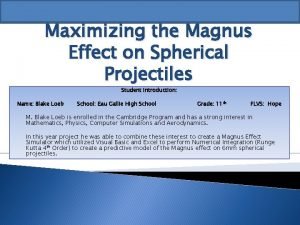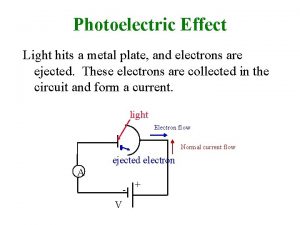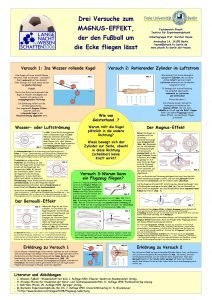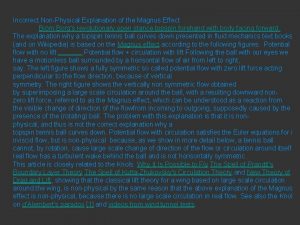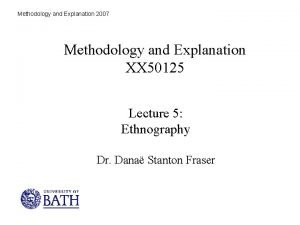Magnus Effect AN EXPLANATION What is Magnus Effect













- Slides: 13

Magnus Effect AN EXPLANATION

What is Magnus Effect? The Magnus effect is an observable phenomenon that is commonly associated with a spinning object that drags air faster around one side, creating a difference in pressure that moves it in

Where it is observable? The most readily observable case of the Magnus effect is where a spinning sphere curves away from the arc it would follow if it were not spinning. It is often used by by soccer players, baseball pitchers and cricket bowlers. Consequently the phenomenon is mostly used to study the

History The magnus effect is named after heinrich Gustav magnus, the german physicist who investigated it. The force on a rotating cylinder is known as Kutta –Joukowski Lift, after Martin Wilhelm Kutta and Nikolai Zzhukovsky ( or joukowski) who first

History(1) German physicist Magnus, described the effect in 1852. However in 1672, Issac Newton had described it and correctly inferred the cause ofter observing tennis players in his Cambridge college. In 1742, Benjamin Robins, a british mathematician , ballistics researcher, and military engineer, explained deviations in the trajectories of musket balls in the terms of Magnus Effect

Physics(1) An intuitive understanding of the phenomenon comes from newtons third law of motion, that the deflective force on the body is a reacton to the deflection that the body imposes on the airflow. The body pushes the air in one direction, and the air pushes the body in other direction. In particular, a lifting force is accompanied by a downward deflection of the air-

Physics(2) It is said that Magnus himself wrongly postulated a theoretical effect with laminar flow due to skin friction and viscosity as the cause of the magnus effect. Such effects are physically possible but slightly in comparision to what produced in Magnus effect proper. In some circumstancs the causes of the magnus effect can produce a deflection

Physics(3) The process by which a turbulent wake develops aft of a body in a airflow is complex, but well-studied in aerodynamics. The thin boundary layer detaches itself from the body at the same point, and this is where the wake begins to develop. The boundary layer itself may be turbulent or not, and that has a significant effect on the wake of formation. Quite small variations in the surface conditions of the body can influence the onset of wake

In Sports In Table tennis, the magnus effect is easily observed, because of the small mass and low density. An experienced player can place a wide variety of spins on the ball. Table tennis rackets usually have a surface made of rubber to give the racket maximum grip on the ball to impart spin The Magnus effect is not responsible for the movement of the cricket ball seen in swing bowling, although it does contribute

In Aviation Some aircraft have been built that use the magnus effect to create lift with a rotating cylinder at the front of the wing, allowing flight at lower horizontal speeds. The earliest attempt to use the magnus effect for a heavierthan-aircraft was in 1910 by a US member of congress, Butler Ames of Massachusetts. The next attempt was in early 1930 s by three

Ship Propulsion and stabilisation Rotor ships use mast-like cylinders for propulsion. The effect is used in a special type of ship stabilizer consisting of a rotating cylinder mounted beneath the waterline and emerging laterally. By controlling the direction and the speed of rotation, strong lift or downforce can be generated. The largest deployement of

A VIDEO – WELL EXPLAINED

THANK YOU

